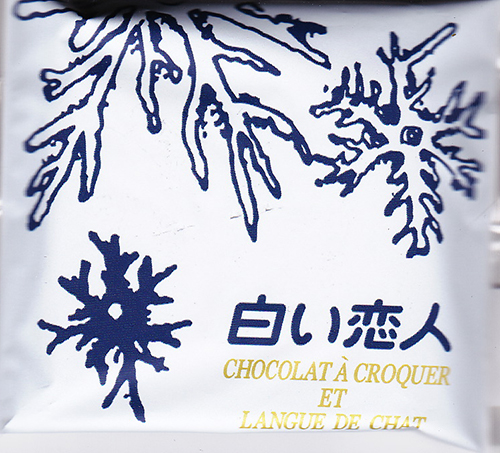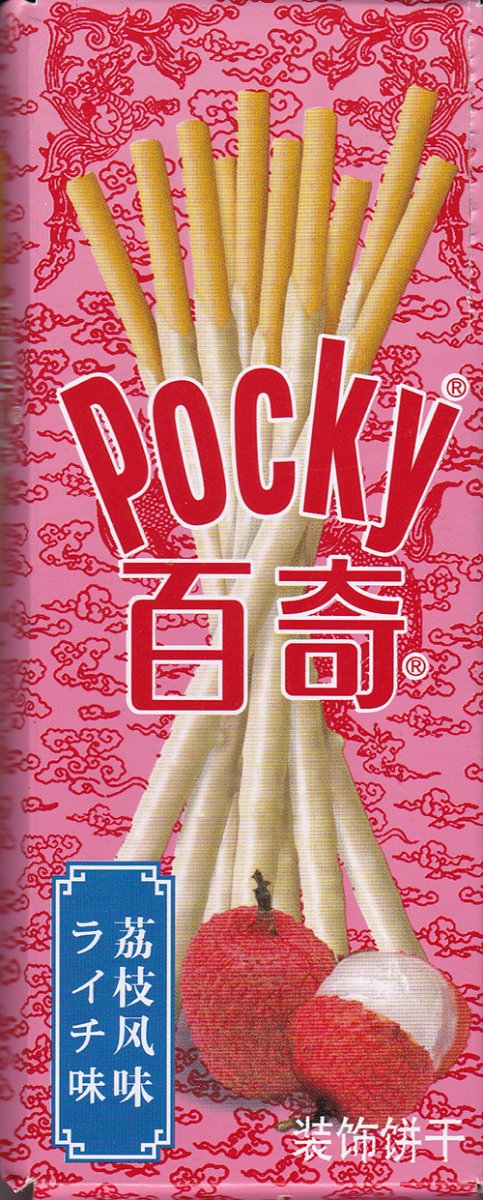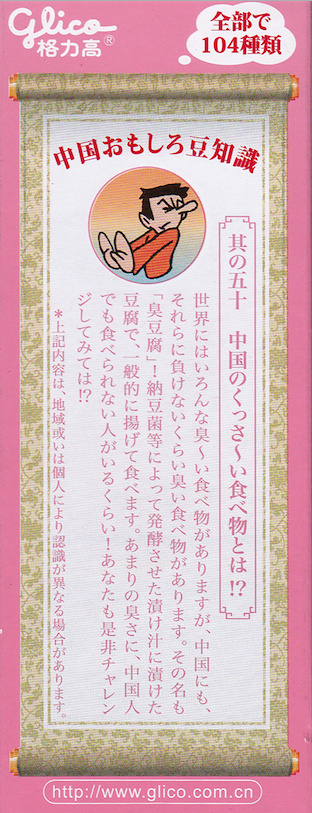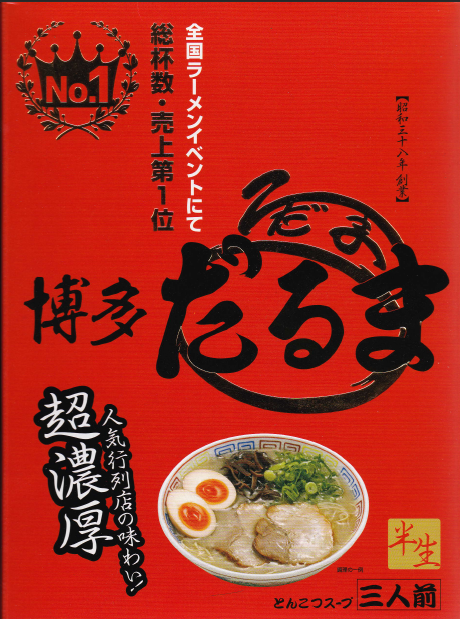White Lovers, Pocky with Lychee, and Daruma Ramen
My husband works closely with people in Japan, Taiwan, and Mainland China, among other places, and when they travel here on business, they inevitably bring presents covered with Chinese characters. He gives them all to me. They usually contain gluten, which I can't handle, so I scan the labels and then hand the items off to someone else to eat. It's quite a supply chain, really.
Anyway, I have now analyzed the packaging with the assistance of my proofreader and can share them with you—another part of the supply chain!
1. White Lover?!

The words on this wafer packaging clearly mean "white lover":
白い (しろい: white)
恋人 (こいびと: lover)
What in the world?! And the "langue de chat" ("cat's tongue" in French) is even stranger!
I would have taken the manufacturer for someone who knew neither French nor Japanese and had made a terrible blunder. But in fact this sweet was specially designed as a souvenir of Sapporo on Hokkaido.
In this concoction, two wafers sandwich white chocolate. The 白い refers to the color of the cookie and the chocolate, also possibly alluding to the snows of Hokkaido. (Yes, that matches an explanation the company has provided.)
Meanwhile, the 恋人 (sweetheart) may connect with the idea of the sweetness of this snack.
As for langue de chat, the type of wafers used, they exist throughout Europe and on some Pacific islands, as well as Japan, says Wikipedia. I still can't believe so many people want to eat something called "cat tongue"!
2. Pocky: The Front

The biscuits on this Pocky box look really bland to me, even though this snack is wildly popular in Japan and even though they're coated with lychee in this case. We find that information in two ways on the lower left, but each requires some explanation.
Before delving into that, I should say that this particular product has come from China. The package has Simplified hanzi on it. That explains the odd name 百奇 (Bǎiqí). This is a phonetic rendering of ポッキー, the katakana way of writing "Pocky." (The name "Pocky" comes from ポッキン, onomatopoeia for the sound of something snapping when it breaks, such a twig. In this case, it's the sound of snapping when one eats a Pocky stick.) In Japanese, 百奇 breaks down as 100 + strange, which seems ... strange! But one Chinese-Japanese dictionary indicates that 奇 (primarily “rare” in Chinese) has a fairly positive connotation in Chinese.
On to the blue box, where we find ライチ味 (ライチあじ: lychee flavor). I've always heard "lychee" pronounced as "lee-chee," so I thought someone got the katakana wrong. But some sources say that the alternate spelling "litchi" can be pronounced as "lie-chee," and that must be the source of ライチ (also written as ライチー).
The hanzi word 荔枝 (lychee) appears to the right of ライチ. I call it hanzi because the non-Joyo 荔 contains three instances of 力 (power), and only the Chinese use that version of the character. By contrast, the Japanese use the non-Joyo variant 茘, which contains three instances of 刀 (single-edged sword). The word 茘枝 conveys "lychee" in Japanese, but native speakers prefer to use ライチ.
Under 荔枝 we find the Simplified Chinese word 风味, which means "distinctive flavor." The non-Joyo 风 corresponds to the Traditional character 風.
So if this treat is made by Chinese for Chinese customers, why have Japanese writing? My proofreader comments that it seems important to the Chinese that Pocky is Japanese. As a result, "They like to have Japanese on the packaging, even if they don’t understand it."
3. Pocky: The Back

There's enough Japanese here to keep us busy for hours or even days, and yet ... the text is about China! Taking the two bits of bold red writing, we find this:
全部で104種類
104 Types in All
全部 (ぜんぶ: all); 種類 (しゅるい: types)
中国おもしろ豆知識
Interesting Trivia About China
中国 (ちゅうごく: China); おもしろ (面白: interesting); 豆知識 (まめちしき: trivia)
As to why the guy is turning away in disgust, the trivia here is about 臭豆腐 (chòudòufu), a stinky type of tofu fermented with the same kind of microbe as natto (納豆 (なっとう: fermented soybeans)). The trivia goes on to say that 臭豆腐 smells so bad that not all Chinese can eat it.
Is that an appetizing or relevant thing to put on a Pocky box?!
4. Ramen

It was easy to find a taker for this ramen, particularly as it's supposed to be an excellent type. Some text on the bottom left tells us so:
人気行列店 (にんきぎょうれつてん: shop so popular that people will stand in line (for ages))
The compressed wording is a little unusual, but it's just the syntax of advertising, and the meaning is quite clear to native speakers (and even to me for a change!).
A few other bits of text jumped out at me:
• ラーメンイベント ("ramen event") probably means “ramen competition” to determine which ramen or ramen place is the best.
• 超濃厚 (ちょうのうこう) means that the broth is super-thick. After all, the term breaks down as super + thick (last 2 kanji).
• 半生 (はんなま) means "half raw," referring to the noodles. That is to say, they aren't 乾麺 (かんめん: dry noodles). Both are types of instant noodles, but generally the former tastes better, whereas the latter keeps longer.
• 三人前 (さんにんまえ) means "three portions." This confused me, as I had no idea that 人前 (にんまえ) meant "portion of food." I thought this term might literally represent the (food) in front of (前) a person (人), but I'm told that the 前 here means "amount," as in 分け前 (わけまえ: share (of the profits)).
All of that intrigues me but not nearly as much as the image on the box. With the help of the だるま, one can spot the face of Daruma (a round, red, limbless doll in the shape of Bodhidharma), which has been done in quite a clever way. The eyes consist of the だ and ま of だるま. And a huge る encloses it all, creating the outline of the head and torso.
Not only that, but I believe the two halves of the hard-boiled egg in the ramen give us the start of another Daruma face with the pork slices finishing it off! My proofreader disagrees. Maybe I've been looking at packaging too long!
By the way, there's a new essay out:
Have a great week!
❖❖❖
Did you like this post? Express your love by supporting Joy o' Kanji on Patreon:



Comments